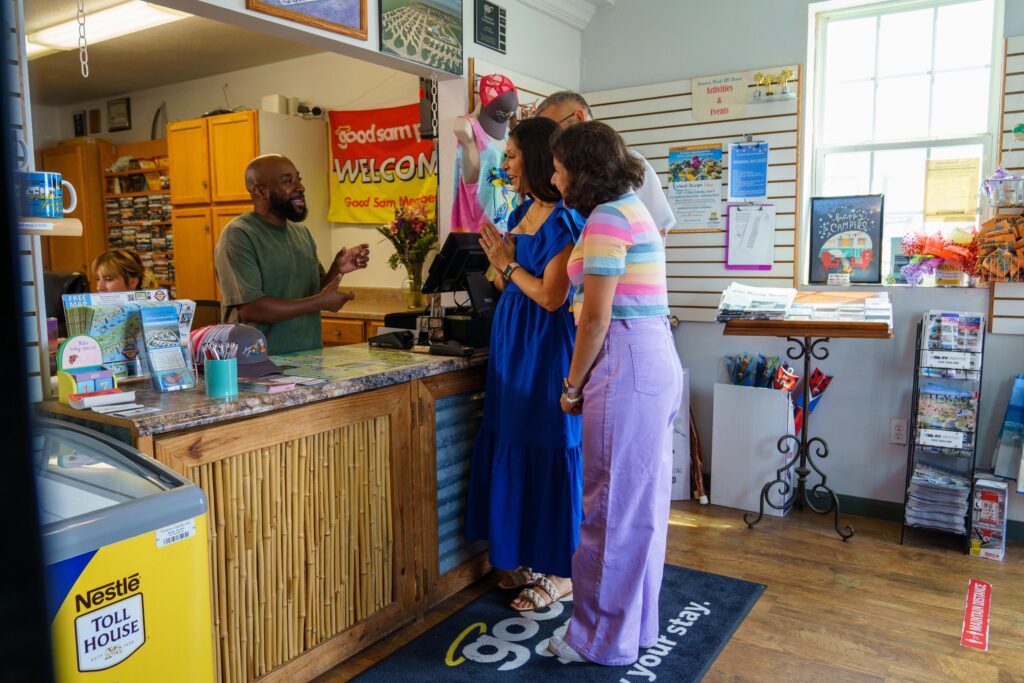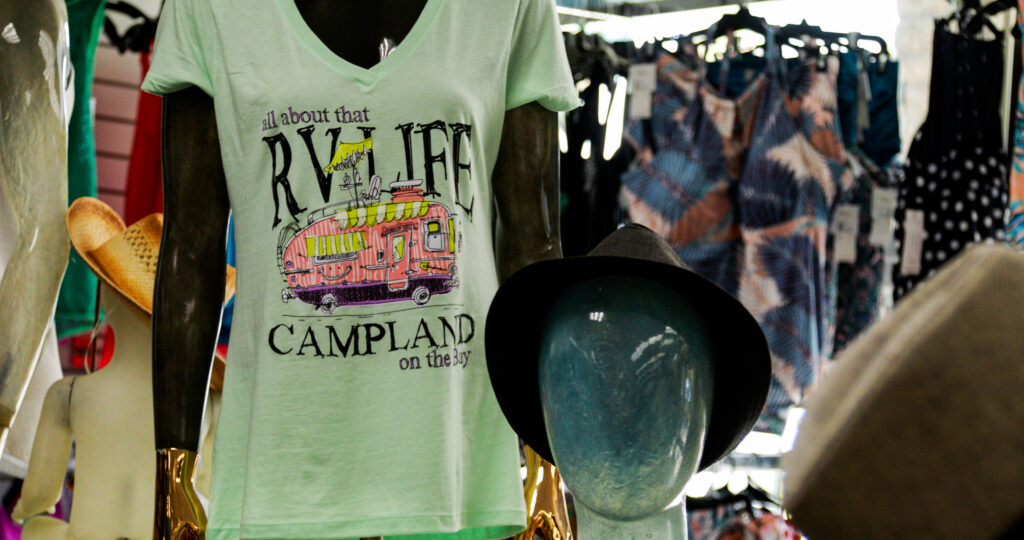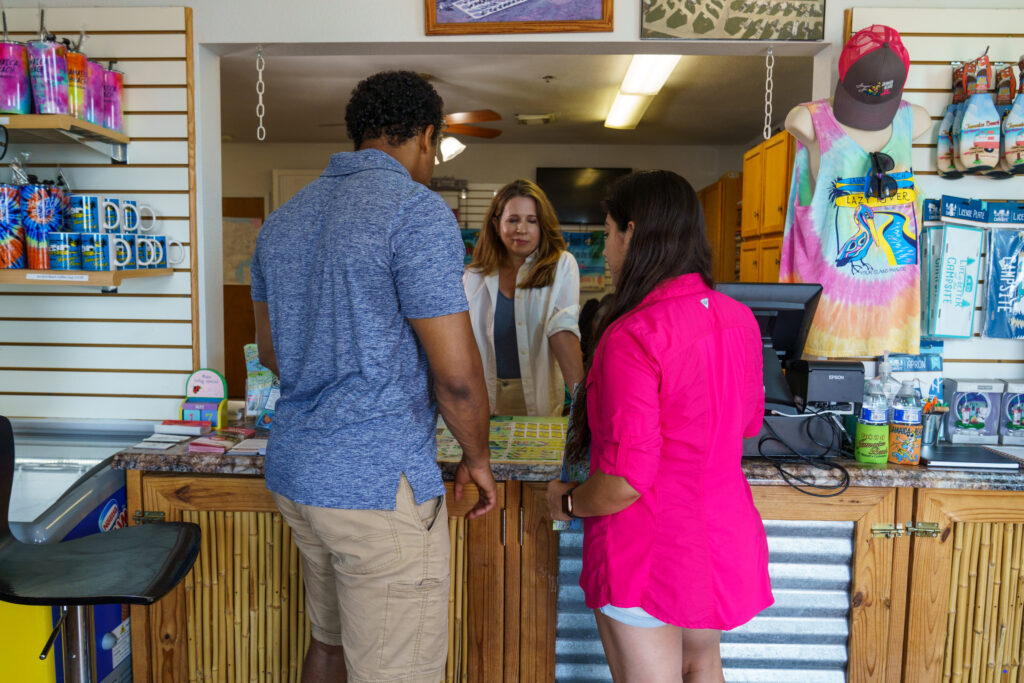The RV campground store is a great opportunity to earn your guests’ trust and return visits. It’s the one place you can have guaranteed face-to-face interaction and make a lasting impression.
Guests visit your store for two main reasons: they have a problem they hope you can solve or they want a casual giftshop experience for knick-knacks and apparel. Both are good sources of additional revenue for your camp. But, more importantly, they are chances to build a rapport with your guests.
Let’s talk about setting up your camp store inventory to ensure you can always be a resource in these two scenarios. Best practices for inventory include 1.) Carrying the right inventory, and 2.) Managing inventory for the best impact on your business.
Cover those bases, and you stand to profit from your sales and continue to build relationships with long-term customers.

What Inventory to Carry
All retail shops carefully choose the inventory they carry based on the customer experience they want to create. But RV campground stores have an especially tall order.
Your space is often limited, and the varying needs of campers are wide, from groceries to firewood to power converters to nightcrawlers. Choose inventory to cover top items from common experiences RVers and campers face–but prioritize inventory that gives you an edge and an opportunity.
Pay Attention To the Small Stuff
A forgotten kitchen item or ingredient. An unexpected need for a first-aid kit. Tools to set up a tent. Deodorant or soap. These small, clutch items might have a low profit margin, but they yield a high return on your customers’ opinions of your campground.
Necessary supplies should be conveniently available to your campers, and you’ll learn what to include more over time. For now, predict the situations campers may find themselves in, and stock your shelves accordingly.
Stock Location-specific Items
Evaluate the needs at your campground and generate a list of camp store inventory items unique to your location. These items are convenient for your customers, but, more importantly, carrying them sends a clear signal that you’ve thought about their experience at your campground.
- Does your campground have sand? A volleyball pit or beach? Consider carrying a few hand vacuums.
- When operating in a location that has campfire bans during summer dry months, stock a few affordable propane campfire alternatives.
- If mosquitos are a nuisance in the evening, carry repellent torches and bug spray, including child and baby-friendly versions.
You know your location better than anyone. And you are best prepared to envision the items your guests will want, need, and value. Plus, you know what’s sold in the past and will likely be needed in the future.
Track Camp Store Inventory Usage
Your previous sales data should be a roadmap for your inventory management. When you track inventory usage, you get an objective look at what sells and how often. Use this to determine your min/max inventory levels, and stock accordingly.
Many campgrounds manually track their sales, and this is part of their inventory management process, reordering goods and products when sales push a certain item below its minimum amount.
However, campground owners may also utilize one of the many camp store applications which help streamline processes like usage tracking. Good Sam Campground Solutions helps you organize sales data, so you know what sells by simply looking up a part number.
Best-Selling Basics
Don’t fix what isn’t broken. Campground visitors will expect certain types of inventory from a camp store, and it’s best to stick to the best-selling categories as your baseline inventory.
Cooking, food, and perishables – Keep the staples on hand, even if in small quantities. Longer shelf-life items like chips, canned goods, oils, and spices are better than perishables. But the goal here is to think of the food and cooking items campers are likely to forget.
Camping gear – Tent spikes, tarps, small tools, propane, RV supplies, ice, charcoal, and outdoor cleaning supplies all sell frequently. Many guests will count on these to be available, so keep a healthy stock.
Personal care – Stock common hygiene essentials–anything from toothbrushes to toilet paper, deodorant, hand sanitizer, and more. And don’t just stick to the cheapest, generic varieties. Ensure you have plenty on hand of products your guests would expect to see at the store.

How to Manage Inventory
The inventory you keep at your camp store should serve two primary purposes: equip your guests (and earn their confidence) and generate revenue for your campground. To do this, source and manage your inventory in a way that optimizes profit. These inventory management tools help get more bang for your buck.
Where to Source Your Camp Store Inventory
The fewer distributors you have to deal with, the better. It’s easier to manage your camp store inventory when you only have to order from one place. But this isn’t always possible with the type of inventory you want to keep. Most campgrounds will work through a wholesaler to provide all their common items. But what about the inventory they don’t cover?
For example, you will likely need to source your campground-branded inventory like t-shirts, mugs, and apparel from a single provider, and that won’t always be a wholesaler.
Take that idea a step further: Are there local products you could stock at your camp store that would generate revenue for your campground and a local product? Locally sourced consumables, home goods, craft and artisanal goods, or locally-themed items? These will often come from individual suppliers. But these have a high sell rate for those visiting the area.
Wholesale Inventory
Source your inventory through wholesalers at a discount, which will decrease the selling price for your guests while allowing you to still profit. There are many wholesalers who specialize in camping products–anything from bug spray and flashlights to multi-tools and tarps, novelty stickers and mugs to coolers and tent poles.
The benefits of buying from a wholesaler include:
- Single source ordering
- Reduced costs on bulk orders
- Reliable availability and deliverability
- Automatic min/max ordering capability.
There can be downsides to working with a single wholesaler. If, for example, they don’t offer a certain brand or product line you want to carry, you’ll have to source that separately, which adds more to the monthly or weekly ordering process. As you seek a wholesaler, consider their product line: do they offer an adequate selection, and how often do they add items to their inventory?
Responsible Price Markups
Camp stores are practical because your guests don’t have to leave the park to access commonly needed items. One could argue that a trip into town disrupts the “away-from-it-all” mindset many go camping to find. Plus, once you set up your RV, staying put is the goal.
For this reason, camp stores have a bit of a monopoly on sales. And, sure, most campers know they will pay more at the camp store than at a grocery store in town. But that doesn’t mean you should increase the price as much as possible. Revenue should come from repeat sales, not overpriced goods.
A rule of thumb for responsible price markups is charging no more than 20 percent for consumable items guests could find cheaper with a trip into town. Bread, milk, produce–those basics shouldn’t sell at extreme markups.
Meanwhile, you can be more aggressive with souvenir and gift items, which often sell at a markup of 45-50 percent. Here, you can choose your prices based on what campers are willing to buy.

Staff Training
Unite your team with a common goal by providing your staff with the necessary training to manage inventory. When everyone knows the importance of accurate inventory, sales data, pricing accuracy, and ordering processes, you create a culture that values an organized camp store.
The more accurate your inventory, the better you’ll become at restocking and the more revenue you’ll bring in over time. And you achieve this when all your staff understands the importance of inventory management.
Plus, when your staff has the same mindset as you, they’ll have conversations with guests to learn which items you ought to be adding to your inventory. If you aren’t communicating with your camp store staff, you’ll never gain these insights.
Guest emergencies are few and far between–and you won’t get many second chances at the camp store to offer clutch inventory when and where your guests need it. Consistent inventory practices save the day.